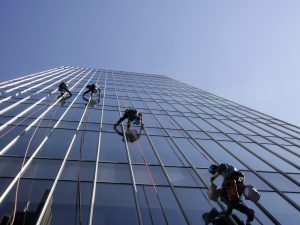Unfortunately, suspended scaffolds, such as window washers scaffolds, make spectacular news items for the local television stations when things go wrong. Based on my familiarity with the standards, regulations, and recommendations regarding the installation and use of single and two point suspended scaffolds, it is amazing that any suspended scaffold accident can happen, much less a spectacular one. The OSHA standards are almost fool proof! Perhaps that is the problem; only a fool would choose not to comply with the available information. The Federal Occupational Safety and Health Administration (OSHA) has very specific standards regarding the erection and use of suspended scaffolds. They address all aspects of suspended scaffolds. In fact, if you compare the suspended scaffold criteria to the other standards, you’ll quickly realize that the suspended scaffold standards are very specific. If that’s the case, then why are there so many suspended scaffold accidents?
Tough question, no easy answer. Perhaps the typical untrained user just doesn’t recognize the hazards. Perhaps the untrained user just doesn’t recognize that there are two types of safety systems for his/her protection and used on all suspended scaffolds. The first system incorporates engineering safety in the design and manufacture of the scaffold and its components while the second system incorporates specific safety products, such as a guardrail. Tampering with either system is asking for trouble.
The parts and pieces that a scaffold erector and scaffold user must install and use prior to operating the scaffold, such as tieback ropes and personal fall protection equipment are examples of specific safety products and are well known to trained erectors and users. Not so well known are engineering safety systems that are “designed into” the scaffold. This would include the strength of the components, safety factors, and types of materials. As an example, a properly engineered suspended scaffold might use aluminum for certain structural components. The aluminum would have a material content that would ensure a sufficient factor of safety. The scaffold erector would not give this too much thought since all this work was done in the design of the component. What does this have to do with safety in the scaffold? A lot if the erector decides to substitute an inferior strength material for the original. Or maybe the user decides that a certain component needs modification because of a certain condition. The modification may alter the strength of the component resulting in a modification of the safety factor. In other words, the component isn’t as strong as it used to be. Since it doesn’t fail on the first use, it is assumed to be safe; but is it? How much strength is left? Does it meet the standards? Good questions. If you feel lucky, you don’t think about that margin of safety. Too bad because the odds, and statistics, indicate that luck probably isn’t on your side.
The same principles apply to wire rope supporting suspended scaffolds. By law this rope is to have a six to one safety factor. That means it has to be six times stronger than the load that will be on it. The strength is engineered into the product at the time of manufacturing. The manufacturer verifies the material strength, size, and fabrication to ensure that a certain strength is always obtained. If the load on the rope is expected to be 1,000 pounds, the rope has to hold 6,000 pounds. Since the six to one safety factor is rather substantial, 31% of scaffold fatalities should not be due to suspension rope failure. But they are. Could it be that the scaffold erector isn’t installing the scaffold correctly? Could it be it was never designed correctly? Could it be the user is abusing the rope? Could it be the rope has been damaged? My experience would suggest that incorrect installation and abuse are the main causes. If that is the case, the solution is training; training that the engineering systems should not be field modified; training in the proper installation of suspension ropes; training in the proper maintenance of suspension ropes; and training in the proper use of suspended scaffold equipment.
For any quality product, including suspended scaffolds, it can be assumed the original engineering is correct. Qualified engineers and manufacturers don’t make a habit of producing faulty products. It can be assumed that trained erectors install safe suspended scaffolds. They don’t make a habit of trying to kill people. It can also be assumed that trained users don’t abuse or modify suspended scaffolds. They don’t like falling to their deaths. So who are those workers who get injured and killed? If it isn’t the trained and the qualified, who is it? Could it be the untrained and unqualified? If you don’t know the answer, call 818-610-0320 and ask about the certified suspended scaffold training program.












